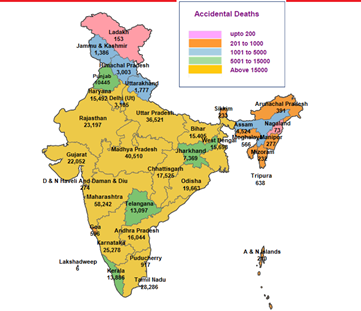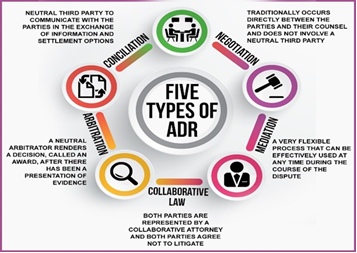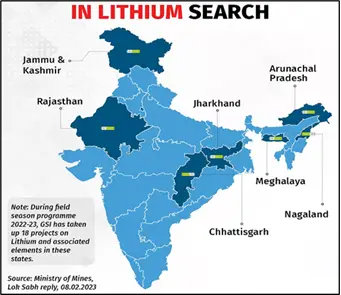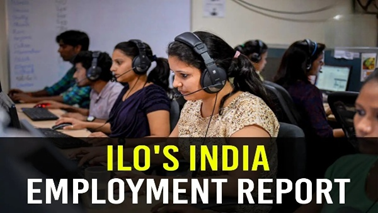Monday, 5th August 2024
Olympics boxing gender testing controversy
Why in the news?
- Imane Khelif, a 25-year-old welterweight from Algeria, qualified for the quarterfinals of the Olympic women's boxing tournament by defeating Italy's Angela Carini in the round of 16, a fight that lasted just 46 seconds.
- Following her victory, Khelif faced a wave of abuse, with many accusing her of being a “biological man” with an “unfair advantage” over Carini.

- Some even wrongly identified Khelif as a transgender woman.
- The participation of trans women and women with certain “masculine” biological characteristics, such as higher testosterone levels, in women’s sports has long been a subject of polarising debate.
Background: The Controversy
- Boxers Failed Gender Eligibility Test Conducted by International Boxing Association (IBA)
- In 2023, Imane Khelif and Chinese Taipei boxer Lin Yu-ting were banned from competing in the IBA’s World Championship in New Delhi after failing a confidential "gender eligibility" test.
- The IBA stated that the boxers did not meet the criteria to compete in the female category.
- Both Boxers Are Competing in Paris Olympics
- Both boxers are now competing at the Paris Olympics, as the International Olympic Committee (IOC) derecognized the IBA over governance and financial issues.
- The IOC-appointed unit governing the competition in Paris only requires the gender stated in an athlete’s passport for eligibility, and Khelif’s passport identifies her as female.
- Response by IOC
- Following Khelif’s win and the subsequent abuse, the IOC stated that all Olympic boxers complied with eligibility and entry regulations.
- It noted that both Khelif and Lin have competed in women’s competitions for many years, including the Tokyo 2020 Games.
- The IOC also criticised the IBA's decision to ban the two women as arbitrary and not following proper procedure.
Gender Eligibility: A Contentious Issue in Women’s Sports:
- Organization of Sports Based on Sex
- Modern sports are organised on the basis of sex, with men and women competing in different categories.
- This is because men, on average, have certain physiological advantages over women.
- Sex Is Determined Based on Chromosomes
- Sex is determined based on chromosomes, which carry genes. Humans have 23 pairs of chromosomes — 22 are identical in men and women; one, the sex chromosome, is different.
- The XX sex chromosomes result in the development of female sex organs, and XY in male sex organs.
- The SRY gene, found on the Y chromosome, is responsible for the production of testosterone.
- Link Between Testosterone and Athletic Performance
- Many studies have supported the link between testosterone and athletic performance.
- The difference in circulating testosterone between adults likely explains most, if not all, sex differences in sporting performance due to testosterone's effects on muscle mass, strength, bone size, strength (density), and circulating haemoglobin.
- DSD and Swyer Syndrome:
- Some people born with female reproductive organs may also carry the XY chromosome, in what is known as Swyer syndrome.
- This syndrome is one of many “Disorders of Sex Development”, or DSDs.
- Swyer syndrome, also known as 46 XY gonadal dysgenesis, is a rare genetic condition where individuals have one X and one Y chromosome in each cell (typically associated with males) but develop female reproductive structures.
- People with Swyer syndrome are genetically male but phenotypically female, meaning they have a female appearance and female external genitalia.
- This is at the heart of the debate surrounding gender eligibility in women’s sports.
- Many argue that to prevent some athletes from having an unfair advantage in women’s sports, women with DSDs must not be allowed to compete with other women.
- They claim that DSDs facilitate greater testosterone production and other consequent athletic advantages.
Steps Taken by Sports Federations to Address This Matter
- Sports Federations Have Their Own Eligibility Criteria
- In 2021, the IOC decided to allow international sports federations to develop their own eligibility rules based on an “evidence-based approach” considering principles of “fairness”, “inclusion”, “non-discrimination”, “no presumption of advantage”, and “prevention of harm.”
- Previously, the IOC required women athletes who had transitioned from male to female to have testosterone levels below 10 nanomoles per litre (nmol/L).
- World Athletics still uses testosterone levels as an eligibility criterion, requiring DSD athletes to maintain levels below 2.5 nmol/L for at least 24 months before competing.
- This is stricter than the pre-2023 requirement of 5 nmol/L for events ranging from 400 meters to a mile, with no restrictions on other events.
- FINA, the world swimming body, the International Cycling Union, and the International Rugby Union have all implemented varying degrees of bans on trans women athletes.
- Debate Goes On
- There is still much unknown about the impact of testosterone on sporting performance.
- Many question whether women born with higher levels of testosterone have any different advantage compared to people with other genetic advantages, such as LeBron James' height or Michael Phelps' large, fin-like hands.
Source: IE
Legal challenges to the Great Nicobar infrastructure project
Why in the news?
- Recently, The Central government's Rs 72,000 crore Great Nicobar Island (GNI) infrastructure project includes constructing an airport for civilian and defence use, an international container transshipment terminal, and a township.
- The project has faced legal challenges in the National Green Tribunal (NGT) and the Calcutta High Court.
- Recently, the Andaman and Nicobar Islands Integrated Development Corporation Limited (ANIIDCO), the project's implementing agency, submitted conclusions from a high-powered committee (HPC) formed by NGT in 2023.
- The HPC concluded that the proposed transshipment port does not fall within the Island Coastal Regulation Zone-IA (ICRZ-IA), where ports are prohibited.
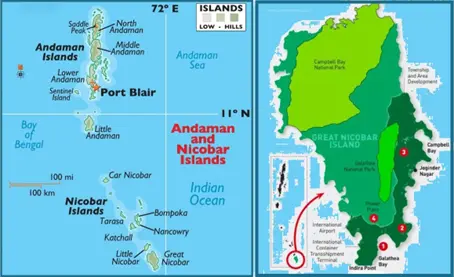
|
Great Nicobar Island:
|
What is the Great Nicobar Island Project?
- About:
- Launch and Location: The Great Nicobar Island (GNI) project, launched in 2021, is a mega project to be implemented at the southern end of the Andaman and Nicobar Islands.
- Components: It involves developing a trans-shipment port, an international airport, township development, and a 450 MVA gas and solar-based power plant on the island.
- Rationale:
- The project was implemented following a NITI Aayog report that identified the potential to leverage the island's advantageous position.
- It is approximately equidistant from Colombo (Sri Lanka) to the southwest and Port Klang (Malaysia) and Singapore to the southeast.
- Features:
- Implementation: The mega infrastructure project is being implemented by the Andaman and Nicobar Islands Integrated Development Corporation (ANIIDCO).
- Key Developments: It includes an International Container Trans-shipment Terminal (ICTT) and a greenfield international airport.
- Strategic Location: Close to the Malacca Strait, the main waterway connecting the Indian Ocean to the Pacific. The ICTT is expected to position Great Nicobar as a major player in the regional and global maritime economy by becoming a key hub for cargo transshipment.
- Site: The proposed site for the ICTT and power plant is Galathea Bay on the southeastern corner of Great Nicobar Island, an area without human habitation.
- Strategic Importance:
- Military Deployment: The project aims to facilitate the deployment of additional military forces, larger warships, aircraft, missile batteries, and troops.
- Surveillance and Security: Enhancing surveillance and building a strong military deterrence on Great Nicobar is vital for India’s national security.
- Regional Significance: The island's proximity to the Malacca Strait is crucial for India's maritime strategy, allowing participation in the global cargo transshipment economy.
- Geopolitical Context: The Bay of Bengal and Indian Ocean regions are crucial for India's strategic and security interests, particularly due to increasing Chinese military presence.
- Chinese Naval Influence: India is concerned about China expanding its naval forces in key Indo-Pacific choke points such as the Malacca, Sunda, and Lombok Straits.
- Regional Military Concerns: China’s efforts to build a military facility on the Coco Islands, located just 55 km north of India's Andaman & Nicobar Islands, raise significant concerns for India’s maritime security.
What are the legal challenges to the GNI Project?
- Grounds for Appeals:
- In 2022, environmental activists challenged the environmental and Coastal Regulation Zone clearances granted to the project.
- They highlighted the impact on the Shompen and Nicobarese tribal communities and the ecological sensitivity of the Island Coastal Regulation Zone (ICRZ-IA).
- Threat to Island Ecology:
- The port project could destroy coral reefs and threaten species like the Nicobar Megapode bird and leatherback turtles in Galathea Bay.
- The project affects about 15% of the island’s land mass, leading to one of the largest forest diversions in a unique rainforest ecosystem.
- The proposed port is in a seismically volatile zone that experienced significant subsidence during the 2004 tsunami.
- NGT's Response and Formation of HPC
- The NGT formed a high-powered committee (HPC) to revisit the project’s green clearance due to concerns about coral conservation, the port’s location in a prohibited area, and limited baseline data.
- The HPC concluded that the proposed port does not fall in the ICRZ-IA.
- Recent Petitions
- In May 2024, Kothari filed two petitions before the NGT’s eastern bench.
- The first challenged the exclusion of parts of the project from ecologically sensitive areas as per the 2019 CRZ notification.
- The second accused the MoEFCC of contempt for not updating the NGT on the HPC’s findings and failing to act as directed.
- ANIIDCO filed a counter affidavit, while MoEFCC requested more time to respond.
- High Court Cases
- The activists also filed a writ petition in the Calcutta High Court challenging the NGT’s April 2023 order.
- The petition argued that the NGT special bench overstepped its jurisdiction and failed to adequately consider the project’s environmental impact, delegating decision-making to the HPC.
- It contended that the NGT should have directly evaluated the clearances and not relied on the committee.
|
UPSC Civil Services Examination, Previous Year Question (PYQ) Prelims Q:1 Which of the following have coral reefs? (2014)
Select the correct answer using the code given below:
Ans: (a)
Q:2 Which one of the following pairs of islands is separated from each other by the ‘Ten Degree Channel’? (2014) (a) Andaman and Nicobar (b) Nicobar and Sumatra (c) Maldives and Lakshadweep (d) Sumatra and Java
Ans: (a)
Q:3 In which one of the following places is the Shompen tribe found? (2009) (a) Nilgiri Hills (b) Nicobar Islands (c) Spiti Valley (d) Lakshadweep Islands
Ans: (b) |
Source: IE
Highest-ever organ transplants in India
Why in the News?
- India achieved a record 18,378 organ transplants in 2023, as reported by the National Organ and Tissue Transplant Organisation (NOTTO), with 10% of these transplants going to foreign nationals.
- This marks the highest number of organ transplants in the country's history, ranking India third globally in organ transplants and second in corneal transplants.
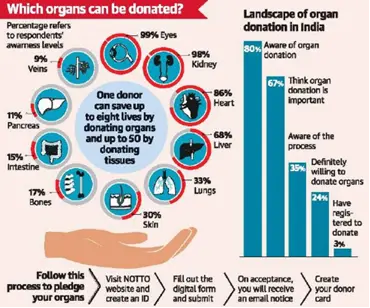
National Organ and Tissue Transplant Organisation (NOTTO):
- About: NOTTO is a national-level organisation under the Directorate General of Health Services, Ministry of Health and Family Welfare.
- Functions: It coordinates the procurement and distribution of organs and tissues and maintains a registry for organ and tissue donations and transplants across India.
Regulatory Frameworks Guiding Organ Transplantation in India
- Legislation:
- The Transplantation of Human Organs Act (THOA), 1994: This act regulates organ transplantation, prohibits organ commercialization, and legalises brain death, allowing deceased donations.
- Rules and Amendments: The act's rules were last amended in 2014, expanding the scope to include tissue transplants.
- Institutions:
- National Organ and Tissue Transplant Organisation (NOTTO): Coordinates organ donation activities and sets policy guidelines and protocols.
- Organ Transplant Rules:
- 2023 Guidelines Update: Removed the 65-year age limit for deceased donor registration. Removed domicile criteria for registering for organ transplants, allowing patients to register and receive transplants in any state.
- Registration and ID: Patients are allotted a unique ID by NOTTO, which remains valid across different hospitals and states.
- Fee Regulations: States are prohibited from charging fees for organ transplant registration.
- Organ Transport Policy: A uniform policy is being developed, with coordination from seven ministries and NITI Aayog, involving nodal officers from each ministry and state-level coordination.
Key Highlights of the Report:
- Status of Organ Transplants:
- Growth: Organ transplants have more than tripled in the past decade. In 2023, India performed 18,378 transplants, with kidney transplants being the most common.
- Global Ranking: India ranks third globally in organ transplants and second in corneal transplants.
- Deceased Organ Donations:
- Milestone: In 2023, India surpassed 1,000 deceased organ donations for the first time, with deceased-donor transplants increasing from 837 in 2013 to 2,935 in 2023.
- Gender Trends in Organ Donation:
- Living Donors: Females (9,784) outnumbered males (5,651) as living donors in 2023.
- Deceased Donors: Males (844) outnumbered females (255) among deceased donors.
- Recipients: Women constituted 30% of organ transplant recipients.
- Transplants to Foreign Nationals:
- Statistics: There were 1,851 transplants for foreign nationals, with Delhi-NCR accounting for 78%.
- Allocation Criteria: Foreign nationals receive organs from deceased donors only when no matching Indian patients are available.
- Irregularities: Allegations of irregularities in transplant approvals for foreign nationals were reported, particularly involving Myanmar nationals purchasing kidneys.
- Organ Donation Rate:
- Current Rate: Less than 1 per million population.
- Need for Improvement: Increased deceased organ donations are necessary to meet the rising demand, driven by the increase in non-communicable and lifestyle diseases.
Source: IE
International Conference of Agricultural Economists
Why in the news?
- Recently, the triennial conference organised by the International Association of Agricultural Economists (IAAE) was held from 02 to 07 August 2024 in India after 65 years.
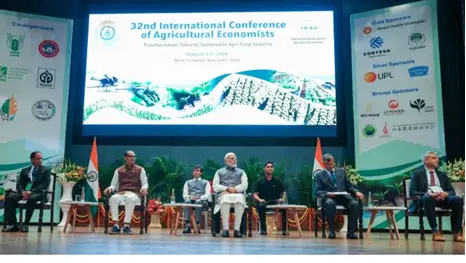
About International Conference of Agricultural Economists (ICAE):
- Organiser: International Association of Agricultural Economists (IAAE).
- Purpose: Facilitates the exchange of knowledge and innovations in agricultural economics, addressing global challenges like food security, rural development, and sustainability.
- Participants: Academics, researchers, government officials, industry professionals, and international organisation representatives.
- Sessions and Topics: Includes keynote addresses, plenary sessions, panel discussions, and paper presentations on agricultural policy, market dynamics, trade, environmental impacts, technological advancements, and rural development.
- Global Impact: Shapes agricultural policies and practices by providing evidence-based insights and recommendations, promoting economic principles to improve agricultural productivity and sustainability.
- Frequency and Location: Held every three years in different locations around the world, emphasising its global scope and reach.
International Conference of Agricultural Economists 2024:
- Dates and Location: Held in India from August 2 to 7, 2024, returning to the country after 65 years.
- Theme: "Transformation Towards Sustainable Agri-Food Systems," focusing on sustainable agriculture amidst global challenges such as climate change, resource degradation, rising production costs, and conflicts.
- Objectives: Highlights India's proactive approach to global agricultural challenges, showcases advancements in agricultural research and policy, and provides a platform for young researchers and professionals to network and strengthen partnerships.
- Impact: Aims to influence policy making on national and global scales and exhibit India's progress in digital agriculture and sustainable agri-food systems.
- Participation: Approximately 1,000 delegates from 75 countries.
Key Highlights of PM Modi’s Speech:
- Welcome: PM Modi welcomed delegates from 75 countries, highlighting India's deep agricultural roots and scientific basis of ancient agricultural practices.
- Diversity and Transformation: Emphasised India’s diverse agro-climatic zones and its transformation from a food-insecure nation to a major global producer.
- Sustainable Farming: Stressed the importance of sustainable and climate-resilient farming practices, including natural farming and climate-resilient crop varieties.
- Global Welfare Commitment: Reiterated India's commitment to global welfare and sharing agricultural innovations and experiences.
- Initiatives: Discussed initiatives like Soil Health Cards, solar farming, e-NAM, and PM Kisan Samman Nidhi to modernise Indian agriculture.
- Digital Technology: Highlighted the use of digital technology for real-time crop surveys, land digitization, and promoting drone use in farming.
- Nutrition and Water Scarcity: Acknowledged the nutrition challenge, water scarcity, and climate change, presenting millet (Shri Anna) as a solution.
- Millet Promotion: Expressed willingness to share India’s millet basket with the world, noting the celebration of the International Year of Millets.
- Conference Impact: Expressed confidence in the conference fostering learning and collaboration towards sustainable agri-food systems.
Source: IE
How to Reduce Landslide Risks
Why in the news?
- Recently, Massive landslides struck the Wayanad district in northern Kerala, resulting in a death toll of 215 and significant destruction.

Possible Causes of Landslide in Wayanad:
- Natural Factors:
- Geological Survey of India (GSI) Findings: Approximately half of Kerala’s land area is prone to landslides.
- Heavy Rainfall and Slope: In Wayanad, 31.54% of the area is highly susceptible to landslides due to heavy rainfall and the region's slope.
- Anthropogenic Factors:
- Increasing Construction Activities: The rise in tourism, including homestays and monsoon tourism, has led to extensive construction of resorts, artificial lakes, and quarrying in eco-sensitive zones (ESZ), heightening landslide risks.
- Changes in Crop Patterns: A 62% reduction in forest cover and a 1,800% increase in plantation areas since the 1950s have weakened topsoil stability, previously maintained by forest roots.
- Climate Change: Altered rainfall patterns and warming of the Arabian Sea have led to more intense and concentrated rainfall, increasing the risk of landslides.
- Issues with Landslide Warnings:
- The Indian Meteorological Department (IMD) issues colour-coded rainfall warnings, but the week before the landslides, the alert was a non-critical yellow.
- The GSI is working on an early warning system for landslides, but it is still in development and may take several years to implement fully.
Landslide Prevention Techniques/Measures:
- Regulatory Measures:
- Banning/Regulating Construction in ESZs: The Gadgil panel report (2011) recommended declaring the Western Ghats as an ESZ to prevent harmful construction activities.
- Institutional Upgrades:
- Enhanced Weather Prediction: IMD should adopt new technologies to improve weather forecasts and warnings.
- Engineering Solutions:
- Slope Stabilization: Adding structural elements to slopes to enhance stability.
- Grading and Terracing: Modifying the slope’s shape and gradient to mitigate landslide risk.
- Soil Reinforcement: Strengthening soil by adding materials to increase slope stability.
- Natural Solutions:
- Vegetation Control: Planting trees, shrubs, or grasses to stabilise soil, absorb excess water, and reduce erosion.
- Mulching: Applying organic or inorganic material to the soil surface to retain moisture and prevent erosion.
- Bioengineering Techniques: Combining plants and engineering methods to stabilise slopes.
- Water Management: Managing water flow to allow gradual infiltration into the soil.
- Monitoring and Preparedness:
- Early Warning Systems: Implementing systems to provide timely alerts and information for landslide risk mitigation.
- Emergency Preparedness: Preparing communities for potential landslide events to minimise risks and enhance response effectiveness.
Initiatives Taken by the Government to Mitigate Landslide Risks:
- National Landslide Risk Management Strategy (2019): A comprehensive strategy covering hazard mapping, monitoring, early warning systems, awareness programs, capacity building, regulations, and mitigation measures.
- Landslide Risk Mitigation Scheme (LRMS): An upcoming scheme providing financial support for site-specific landslide mitigation projects, disaster prevention, R&D in monitoring, and early warning system development.
- Flood Risk Mitigation Scheme (FRMS): An upcoming scheme focused on developing model flood shelters, river basin-specific flood early warning systems, and digital elevation maps for inundation models and early evacuation warnings.
- National Guidelines on Landslides and Snow Avalanches: Guidelines from the National Disaster Management Authority (NDMA) addressing hazard assessment, vulnerability analysis, risk management, structural and non-structural measures, institutional mechanisms, and community participation.
- Landslide Atlas of India: A document by the National Remote Sensing Centre (NRSC) detailing landslide occurrences and damage assessments in India’s landslide-prone areas.
|
UPSC Civil Services Examination, Previous Year Questions (PYQs) Mains: Q:1 Differentiate the causes of landslides in the Himalayan region and Western Ghats. (2021) Q:2 The Himalayas are highly prone to landslides.” Discuss the causes and suggest suitable measures of mitigation. (2016) |
Source: DC
Maritime Partnership Exercise
Why in the news?
- Recently, a Maritime Partnership Exercise (MPX) was conducted between India and Russia in St. Petersburg.

Maritime Partnership Exercise:
- About:
- The MPX was held in St. Petersburg to celebrate the 328th Russian Navy Day.
- Participating Ships: INS Tabar (India) and Soobrazitelny (Russia).
- It marked a milestone in India-Russia maritime cooperation, highlighting both nations' commitment to regional peace, stability, and security.
- The exercise included complex naval manoeuvres such as communication drills, Search & Rescue operations, and Replenishment at Sea, showcasing high professionalism and interoperability.
- Significance:
- The exercise underscored the strong bilateral naval ties between India and Russia.
- It reflects India's dedication to fostering global naval partnerships and enhancing maritime cooperation.
Key Facts about INS Tabar:
- Type: Stealth frigate built in Russia for the Indian Navy.
- Class: Third of the Talwar-class frigates.
- Commissioned: April 19, 2004, in Kaliningrad, Russia.
- Capabilities: Handles air, surface, and sub-surface missions; operates independently or as part of a larger naval task force.
- Affiliation: Part of the Indian Navy's Western Fleet, based in Mumbai under the Western Naval Command.
Source: PIB
Price Monitoring System App
Why in the news?
- On August 4, 2024, the Union Minister of Consumer Affairs, Food and Public Distribution & New and Renewable Energy launched Version 4.0 of the Price Monitoring System (PMS) Mobile app.
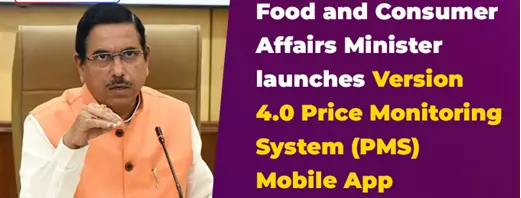
About the App:
- Agency: Managed by the Price Monitoring Division (PMD) in the Department of Consumer Affairs.
- Purpose: Monitors prices of selected essential commodities.
- Initial Launch: The PMS App was launched in 2021 to enhance the quality of price data by facilitating daily price reporting from various centers.
- Price Data Sources: Retail and wholesale prices are collected daily from 550 centers via State Civil Supplies Departments using the PMS App.
Commodities Monitored:
- Existing: 22 essential commodities including Rice, Wheat, Sugar, Oil, Tea, Milk, and more.
- New Additions: 16 new items such as Bajra, Jowar, Ghee, Butter, Brinjal, and Banana.
- Coverage: The 38 commodities now monitored cover about 31% of the total Consumer Price Index (CPI) weights, up from 26.5% with the previous 22 commodities.
Significance:
- The data collected aids in formulating policy decisions and provides insights on CPI inflation for the Government, RBI, and analysts.
Article 311 of Indian Constitution
Why in the news?
- The Jammu and Kashmir Lieutenant-Governor recently invoked Article 311 to terminate the services of six government employees.

About Article 311:
- Purpose: Provides procedural safeguards and protections against arbitrary dismissal, removal, or reduction in rank of government employees.
- Safeguards:
- Inquiry Requirement: Government employees cannot be dismissed, removed, or reduced in rank without an inquiry.
- Opportunity to Defend: Employees must be informed of the charges and given a chance to defend themselves.
- Authority: Only the appointing authority or someone of equal or higher rank can remove a civil servant.
- Grounds for Action:
- Efficiency: Unsatisfactory performance or conduct affecting government efficiency.
- Moral Turpitude: Involvement in corruption, bribery, fraud, or similar offences.
- Procedure:
- Formulation of Charges: Clear charges must be formulated against the employee.
- Opportunity to Respond: Employees must be given a chance to respond and present their defence.
- Conducting Inquiry: An impartial inquiry must be conducted.
- Consideration of Report: The inquiry report must be considered before making a decision.
- Decision-making: The decision must be reasoned, fair, and communicated to the employee.
- Exceptions:
- Security of the State: Immediate action can be taken if deemed necessary for state security, bypassing the inquiry process.
- Public Service Efficiency: The President or Governor can dispense with the inquiry for efficiency reasons.
- Probationary Employees: Probationary employees can be dismissed without an inquiry.
- Judicial Review:
- Decisions under Article 311 are subject to judicial review, and remedies may include reinstatement, back wages, or other appropriate reliefs.
Source: TH
Mahila Samman Savings Certificate (MSSC) Scheme
Why in the news?
- The Centre is considering not extending the Mahila Samman Savings Certificate (MSSC) scheme beyond its March 2025 deadline.
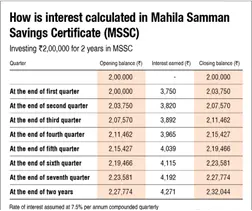
About the MSSC Scheme:
- Introduction:
- Announced in Budget 2023 as a one-time scheme.
- Available for a two-year period, concluding in March 2025.
- Aimed at women and girls of all age groups.
- Key Features:
- Deposit Facility:
- Maximum deposit limit of ₹2 lakh per account.
- Minimum deposit of ₹1000, with subsequent deposits in multiples of ₹100.
- Interest Rate:
- Fixed interest rate of 7.5% per annum.
- Interest is compounded quarterly and credited to the account.
- Tenure:
- 2-year lock-in period from the date of account opening.
- Partial withdrawal of up to 40% of the balance permitted after one year.
- Account Opening:
- Open to individual women.
- Minor accounts can be opened by guardians.
- Multiple accounts allowed with a minimum gap of three months between openings.
- Total deposit across all accounts cannot exceed ₹2 lakh.
- Deposit Facility:
- Objective:
- To promote formal financial savings among women.
- Tax Benefits:
- No tax benefits are associated with this scheme.
Source: BS
Transforming Biodiversity Conservation in India
Context:
- India, a megadiverse nation with over 8% of global biodiversity in just 2.4% of Earth's land area, faces a critical challenge in balancing development and conservation.
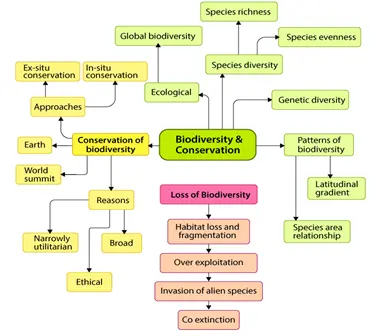
What is the Significance of Biodiversity for India?
- Ecological Significance:
- India, a megadiverse country, relies on its biodiversity for ecological stability.
- The Western Ghats influence monsoon patterns critical for agriculture.
- Sundarbans mangroves protect coastal areas from cyclones and tsunamis.
- Over 50% of cultivated plants in India depend on pollinators.
- Economic Significance:
- Biodiversity supports the livelihoods of around 275 million people through forest resources.
- Ecotourism driven by India's flora and fauna significantly contributes to the economy.
- Cultural and Traditional Significance:
- India's biodiversity is deeply linked with cultural practices and traditions.
- Sacred groves preserve biodiversity and hold cultural importance.
- Traditional medicine systems like Ayurveda, Siddha, and Unani rely on the country's rich biodiversity.
- Scientific and Medicinal Significance:
- India's biodiversity is crucial for scientific research and drug discovery.
- The Cinchona tree has contributed to anti-malarial drugs.
- With over 8000 medicinal plant species, India’s genetic diversity supports the development of climate-resilient crops.
- Climate Change Mitigation and Adaptation:
- Biodiversity aids climate strategies; forests act as carbon sinks, absorbing around 7% of India's GHG emissions.
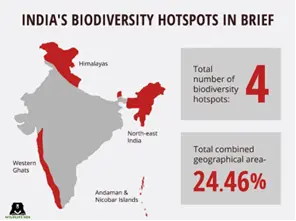
What are the efforts related to biodiversity conservation in India?
- Constitutional and Legal Provisions:
- Article 48A: Directs the state to protect the environment, including forests and wildlife.
- Article 51A(g): Makes it a fundamental duty of citizens to protect the environment.
- Environment (Protection) Act, 1986: Empowers pollution control and conservation efforts.
- Biological Diversity Act, 2002: Aims for conservation, sustainable use, and equitable sharing of biological resources.
- Animal Welfare Board of India vs A. Nagaraja & Ors (2014): Supreme Court recognized the right of every species to live.
- Mk Ranjit Singh vs. Union of India: Affirmed the right to a healthy environment and balanced conservation with climate action.
- Major Committees Related to Biodiversity Conservation:
- Madhav Gadgil Committee:
- Recommended 64% of the Western Ghats as Ecologically Sensitive Areas (ESA).
- Proposed a ban on new large dams and polluting industries in sensitive zones.
- Existing industries should achieve zero pollution by 2016.
- Established the Western Ghats Ecology Authority with statutory powers.
- Kasturirangan Committee:
- Suggested 37% of Western Ghats as ESA.
- Recommended a ban on mining, quarrying, and new thermal power projects.
- Proposed restrictions on hydropower projects and construction.
- Madhav Gadgil Committee:
Key threats to Biodiversity in India:
- Habitat Loss:
- Rapid urbanisation and agricultural expansion have led to significant habitat loss.
- From 2001 to 2020, India lost 1.93 million hectares of tree cover, a 5.2% decrease since 2000.
- Fragmentation in areas like the Western Ghats threatens species such as the lion-tailed macaque.
- Development projects, such as the Mumbai-Ahmedabad bullet train, impact critical habitats like Thane Creek Flamingo Sanctuary.
- Invasive Species:
- Non-native species are disrupting ecosystems.
- Alien plants like Lantana camara and Prosopis juliflora, introduced during British colonisation, threaten native flora.
- Lantana has invaded 44% of India’s forests, while the giant African snail in the Andaman Islands and Fall Armyworm affecting maize crops exemplify invasive species' impact.
- Climate Change:
- Climate change is altering habitats and migration patterns.
- Sundarbans mangroves face sea-level rise and habitat squeeze.
- Warming temperatures in the Himalayas are pushing species like the snow leopard to higher altitudes.
- Coral reefs, including those in the Gulf of Mannar, have seen a decline in live coral cover, from 37% in 2005 to 27.3% in 2021.
- Human-Wildlife Conflict:
- Expanding human settlements increase conflicts with wildlife.
- Annual reports indicate over 500 human and 100 elephant deaths due to conflict.
- Cases like the relocation of a tiger from Ranthambore reserve highlight ongoing challenges.
- Genetic Erosion:
- Modern agricultural practices threaten agrobiodiversity.
- The shift to hybrid crop varieties has led to a decline in traditional rice varieties from 110,000 in the 1970s to about 6,000 today, impacting food security and resilience.
- Pollution:
- Pollution severely affects biodiversity.
- The Yamuna River has become biologically dead in a 22 km stretch in Delhi due to industrial effluents.
- Microplastic pollution in the River Ganga and light pollution affecting nesting sea turtles exemplify the widespread impact of pollution.
- Policy Implementation:
- Despite strong environmental laws, implementation is often inadequate.
- Controversies like the rejection of the Etalin Hydroelectric Project in Arunachal Pradesh highlight gaps in policy enforcement.
- Urban Biodiversity Loss:
- Rapid urbanisation is reducing urban ecosystems.
- Nearly one-third of natural wetlands have been lost due to urban expansion and pollution.
- The decline of house sparrows in cities, with reductions over 80% in some areas, demonstrates the impact on common species.
What are the strategies to improve biodiversity conservation in India?
- Ecosystem-based Management:
- Shift from species-centric to ecosystem-based conservation by protecting entire ecological networks.
- Example: Declaring 438.904 sq km around Mudumalai Tiger Reserve as an eco-sensitive zone.
- Actions:
- Integrate mapping into land-use planning at state and district levels.
- Provide incentives for local communities to maintain ecological corridors.
- Community-led Conservation:
- Engage local communities in conservation efforts, leveraging successful examples like Van Panchayats and private conservation projects.
- Actions:
- Strengthen and expand Joint Forest Management Committees.
- Provide legal recognition to Community Conserved Areas.
- Develop capacity-building programs for conservation techniques.
- Green Infrastructure:
- Integrate biodiversity considerations into infrastructure development.
- Actions:
- Implement mandatory biodiversity impact assessments for major infrastructure projects.
- Develop national standards for wildlife crossings and green bridges.
- Promote urban biodiversity through green roofs, vertical gardens, and urban forests.
- Sustainable Agriculture:
- Enhance biodiversity through sustainable agricultural practices.
- Actions:
- Scale up agro-ecological models like Zero Budget Natural Farming.
- Provide incentives for crop diversification and on-farm biodiversity.
- Create market linkages for agrobiodiversity products.
- Technology-driven Conservation:
- Utilise technology to bolster conservation efforts.
- Actions:
- Employ satellite imagery and AI for real-time monitoring.
- Use eDNA techniques for non-invasive biodiversity monitoring.
- Biodiversity Financing:
- Secure sustainable funding for long-term conservation.
- Actions:
- Expand the Compensatory Afforestation Fund to cover broader conservation projects.
- Develop green bonds specifically for biodiversity.
- Climate-adaptive Conservation:
- Adapt conservation strategies to climate change impacts.
- Actions:
- Conduct vulnerability assessments of key ecosystems and species.
- Develop climate-resilient protected area networks.
- Maintain climate refugia in different biogeographic zones.
- Invasive Species Management:
- Address invasive species through coordinated efforts.
- Actions:
- Establish a national monitoring and early warning system.
- Strengthen quarantine measures at ports and borders.
- Launch public awareness campaigns on invasive species impacts.
- Genetic Resource Conservation:
- Preserve genetic diversity for future adaptability.
- Actions:
- Expand gene banks for wild and domesticated species.
- Implement in-situ conservation for crop wild relatives.
- Create a digital database of genetic resources.
- Promote research on genomics for conservation of threatened species
|
UPSC Civil Services Examination, Previous Year Questions (PYQs) Prelims Q1. Which of the following can be threats to the biodiversity of a geographical area? (2012)
Select the correct answer using the codes given below:
Ans: (a)
Q2. Biodiversity forms the basis for human existence in the following ways: (2011)
Select the correct answer using the codes given below:
Ans: (d)
Mains Q:1 How does biodiversity vary in India? How is the Biological Diversity Act,2002 helpful in the conservation of flora and fauna? (2018) |
Source: HT
Share the article
Edukemy’s Current Affairs Quiz is published with multiple choice questions for UPSC exams
MCQ
Get Latest Updates on Offers, Event dates, and free Mentorship sessions.

Get in touch with our Expert Academic Counsellors 👋
FAQs
UPSC Daily Current Affairs focuses on learning current events on a daily basis. An aspirant needs to study regular and updated information about current events, news, and relevant topics that are important for UPSC aspirants. It covers national and international affairs, government policies, socio-economic issues, science and technology advancements, and more.
UPSC Daily Current Affairs provides aspirants with a concise and comprehensive overview of the latest happenings and developments across various fields. It helps aspirants stay updated with current affairs and provides them with valuable insights and analysis, which are essential for answering questions in the UPSC examinations. It enhances their knowledge, analytical skills, and ability to connect current affairs with the UPSC syllabus.
UPSC Daily Current Affairs covers a wide range of topics, including politics, economics, science and technology, environment, social issues, governance, international relations, and more. It offers news summaries, in-depth analyses, editorials, opinion pieces, and relevant study materials. It also provides practice questions and quizzes to help aspirants test their understanding of current affairs.
Edukemy's UPSC Daily Current Affairs can be accessed through:
- UPSC Daily Current Affairs can be accessed through Current Affairs tab at the top of the Main Page of Edukemy.
- Edukemy Mobile app: The Daily Current Affairs can also be access through Edukemy Mobile App.
- Social media: Follow Edukemy’s official social media accounts or pages that provide UPSC Daily Current Affairs updates, including Facebook, Twitter, or Telegram channels.

